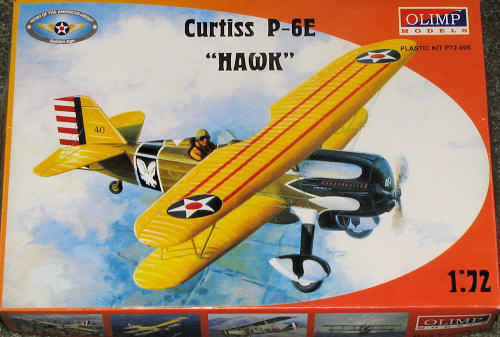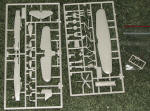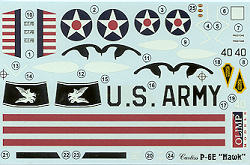
| KIT: | Olimp1/72 P-6E Hawk |
| KIT #: | P72006 |
| PRICE: | $12.00 is what I paid at the Nationals |
| DECALS: | Two options |
| REVIEWER: | Scott Van Aken |
| NOTES: | Finally, a replacement for the old, but still nice Monogram kit. |

| HISTORY |
The P-6E, a first-line
pursuit aircraft of the early 1930s, was the last of the fighter biplanes built
in quantity for the Army Air Corps. The P-6 series of aircraft had 13 distinct
sub-types of 8 different models, A-H, (although the C model conversion was
cancelled before completion). The U.S. Army Air Corps placed an order for 18
P-6s in 1929. The P-6 was another modification of the basic P-1; in this case
the P-1B.
Originally designated the Y1P-22, it was later redesignated the P-6E because of
the similarity to the other P-6 series airplanes. The P-6E was never used in
combat, but it is perhaps the best-known of all the "between wars" Army pursuit
aircraft. Despite its excellent performance, only 46 P-6E's were ordered because
of the shortage of funds for the Air Corps during the austere days of the
depression.
| THE KIT |
 This
one sort of surprised me when I saw them on a dealer's table at the US
nationals. I took a look at it and knew that it had to be in my collection.
Prior to this, the only model in this scale of this airplane was the quite old,
but still very accurate Monogram kit. Its only downside was the lack of any
interior and some minor simplification of details. This has been taken care of
with this kit from Olimp.
This
one sort of surprised me when I saw them on a dealer's table at the US
nationals. I took a look at it and knew that it had to be in my collection.
Prior to this, the only model in this scale of this airplane was the quite old,
but still very accurate Monogram kit. Its only downside was the lack of any
interior and some minor simplification of details. This has been taken care of
with this kit from Olimp.
Molded in a grey plastic, there are two large and one small sprue. The parts have some a bit of flash on some of them, but it is minor. The fabric representation is quite good and not the 'hills and valleys' that one often sees on these types of kits. I also found a slightly sunken in area on the upper surface of the upper wing that will be difficult to fix. More than likely I'll leave it as it is as it may 'disappear' under a coat of paint. There is a large ejector mark in the center of the seat that will be difficult to remove unless one is good with a motor tool or small chisels.
What this kit has that the Monogram lacks are options. Not many on an airplane of this era, but they are nice to have. One is the ability to have either full wheel spats or the ones with open sides. There is also a long range fuel tank that can be added.
 Instructions
are well done and provide color references with Humbrol, ModelMaster and Revell
paints. A full rigging diagram is also provided. Markings are for two aircraft.
One is the well known 17 Pursuit Squadron markings from 1933 as shown on the box
art. This has an OD fuselage and Orange/Yellow wings. The other is from Wright
Field circa 1937 with a blue fuselage. Interestingly, this latter color is not
given in the paint guide. Nor are the overall colors shown in the markings
diagrams. Overall color is determined by looking on the side of the box. The
decals are very well done, though the reds seem a bit subdued to my eyes and the
wing bands a bit wide (but these can be easily trimmed down if need be). The
sheet provides all the difficult markings for the 17th PS aircraft, so no
intensive masking is required.
Instructions
are well done and provide color references with Humbrol, ModelMaster and Revell
paints. A full rigging diagram is also provided. Markings are for two aircraft.
One is the well known 17 Pursuit Squadron markings from 1933 as shown on the box
art. This has an OD fuselage and Orange/Yellow wings. The other is from Wright
Field circa 1937 with a blue fuselage. Interestingly, this latter color is not
given in the paint guide. Nor are the overall colors shown in the markings
diagrams. Overall color is determined by looking on the side of the box. The
decals are very well done, though the reds seem a bit subdued to my eyes and the
wing bands a bit wide (but these can be easily trimmed down if need be). The
sheet provides all the difficult markings for the 17th PS aircraft, so no
intensive masking is required.
| CONCLUSIONS |
It is nice to see that someone is paying attention to 1/72 scale when it comes to these mid-war aircraft. I can only hope that Olimp realizes that it has found a bit of a gold mine when it comes to these planes in general and Curtiss in particular. Hopefully we'll see more from this time frame in the future.
| REFERENCE |
You can thank me and my funds for this one.
September 2006
If you would like your product reviewed fairly and fairly quickly by a site that has over 325,000 visitors a month, please contact me or see other details in the Note to Contributors.